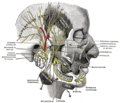Parotid gland
Parotid gland is the largest of the salivary glands. It is found in humans and most other mammals, located bilaterally in the cheek, in front of the ear, and extending to the space below the ear. The gland secretes saliva through the parotid duct into the mouth, which facilitates mastication and swallowing, and also participates in oral hygiene.
Anatomy
The parotid gland is wrapped around the mandibular ramus, and secretes saliva through the parotid duct (Stensen duct) which opens into the mouth at the level of the upper second molar. The gland is divided into two lobes by the facial nerve.
Function
The primary function of the parotid gland is the production of saliva. Saliva produced by the parotid gland is serous and rich in amylase, an enzyme that breaks down starch into sugar.
Clinical significance
Diseases of the parotid gland can result in considerable discomfort and can also be a symptom of systemic diseases such as Sjögren's syndrome or HIV.
Parotitis
Parotitis is an inflammation of one or both parotid glands. Acute bacterial parotitis is most often caused by Staphylococcus aureus but can be caused by other bacteria. Chronic parotitis can have various causes, from autoimmune diseases, such as Sjögren's syndrome, to obstructive diseases, such as lithiasis (stone formation).
Parotid tumors
Most tumors of the parotid gland are benign, but the gland is also a site where malignant tumors can form. The most common benign tumor of the parotid gland is a pleomorphic adenoma.
See also
Parotid_gland
Transform your life with W8MD's budget GLP-1 injections from $125.
W8MD offers a medical weight loss program to lose weight in Philadelphia. Our physician-supervised medical weight loss provides:
- Most insurances accepted or discounted self-pay rates. We will obtain insurance prior authorizations if needed.
- Generic GLP1 weight loss injections from $125 for the starting dose.
- Also offer prescription weight loss medications including Phentermine, Qsymia, Diethylpropion, Contrave etc.
NYC weight loss doctor appointments
Start your NYC weight loss journey today at our NYC medical weight loss and Philadelphia medical weight loss clinics.
- Call 718-946-5500 to lose weight in NYC or for medical weight loss in Philadelphia 215-676-2334.
- Tags:NYC medical weight loss, Philadelphia lose weight Zepbound NYC, Budget GLP1 weight loss injections, Wegovy Philadelphia, Wegovy NYC, Philadelphia medical weight loss, Brookly weight loss and Wegovy NYC
|
WikiMD's Wellness Encyclopedia |
| Let Food Be Thy Medicine Medicine Thy Food - Hippocrates |
Medical Disclaimer: WikiMD is not a substitute for professional medical advice. The information on WikiMD is provided as an information resource only, may be incorrect, outdated or misleading, and is not to be used or relied on for any diagnostic or treatment purposes. Please consult your health care provider before making any healthcare decisions or for guidance about a specific medical condition. WikiMD expressly disclaims responsibility, and shall have no liability, for any damages, loss, injury, or liability whatsoever suffered as a result of your reliance on the information contained in this site. By visiting this site you agree to the foregoing terms and conditions, which may from time to time be changed or supplemented by WikiMD. If you do not agree to the foregoing terms and conditions, you should not enter or use this site. See full disclaimer.
Credits:Most images are courtesy of Wikimedia commons, and templates, categories Wikipedia, licensed under CC BY SA or similar.
Contributors: Prab R. Tumpati, MD






